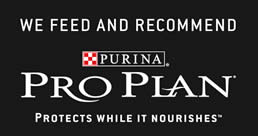
General Appearance
The Pointer is bred primarily for sport afield; he should unmistakably look and act the part. The ideal specimen gives the immediate impression of compact power and agile grace; the head noble, proudly carried; the expression intelligent and alert; the muscular body bespeaking both staying power and dash. Here is an animal whose every movement shows him to be a wide awake, hard-driving hunting dog possessing stamina, courage, and the desire to go. And in his expression are the loyalty and devotion of a true friend of man.
Temperament
The Pointer's even temperament and alert good sense make him a congenial companion both in the field and in the home. He should be dignified, yet show a responsive attitude at all times.
Balance and Size
Balance – over-all symmetry – is much more important in the Pointer than size. It is just as vital in a dog bred for field work as it is in an athlete or a racehorse, and for the same reasons: it indicates muscular coordination, endurance, and an equilibrium of power. Whether large or small a well put-together Pointer, "smooth all over," is preferred to an uneven one with contrasting good and bad points. Provided there is balance, considerable variation in size and weight is permissible.
Coat and Colour
Coat short, dense and smooth with a sheen. Liver, lemon, black, orange; either in combination with white or solid-coloured. A good Pointer cannot be a bad colour. In the darker colours, the nose should be black or brown; in the lighter shades it may be lighter or flesh-coloured.
Head
Skull: long and proportionately wide, but indicating length rather than width. Slight furrow between the eyes, cheeks cleanly chiseled. A pronounced stop midway between nostrils and occiput.
Muzzle: long, in the same plane as the skull. Nostrils large, spongy, widely open.
Jaws: ending level and square, with scissors or even bite, the flews clean.
Eyes: of medium size, rounded, pleasant in expression and the darker the better.
Ears: set on at eye level. When hanging naturally, they should be somewhat pointed at the tip – never round – and soft and thin in leather. They should reach below the lower jaw, close tot he head, with little or no folding.
Neck
Long, dry, muscular and slightly arched, springing cleanly from the shoulders.
Forequarters
Shoulders long, thin and sloping. The top of blades close together. Elbows well down, directly under the withers and truly parallel, so as to work just clear of the body. Forelegs straight and with oval bone. Knee joint never to knuckle over. Pasterns of moderate length, perceptibly finer in bone than the leg, and slightly slanting.
Body
Back strong and solid, with only a slight rise from croup to top of shoulders. Chest, deep rather than wise, must not hinder free action of the forelegs. The breastbone bold without being unduly prominent. The ribs well sprung, descending as low as the elbow-point. Loin of moderate length, powerful and slightly arched. Croup falling only slightly to base of tail. Tuck-up should be apparent, but not exaggerated.
Hindquarters
Muscular and powerful, with great propelling leverage. Thighs long and well developed. The hocks clean and parallel. Stifles wide and well bent. Decided angulation is the mark of power and endurance. Feet oval, with long, closely-set toes, well padded and deep.
Tail
Heavier at the root, gradually tapering to a fine point. Length no greater than to reach the hock joint. Carried straight, ideally on a level with the back.
Gait
Smooth and frictionless, with a powerful hindquarters' drive. The head should be carried high, the nostrils wide, the tail moving from side to side rhytmically with the pace, giving the imrpession of a well balanced, strongly-built hunting dog capable of top speed combined with great stamina